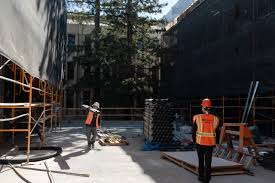
After weeks of political suspense, California Gov. Gavin Newsom has officially signed Senate Bill 79, enacting one of the most sweeping state-level land use reforms in modern history. The new law will allow significantly taller apartment buildings — in some cases up to nine stories — near major public transit stops across California’s largest urban counties, overriding local zoning restrictions.

“The world looks to California for leadership — it’s time to build modern, connected communities that fulfill California’s promise, meeting the needs of today and the next generation,” Newsom wrote in his signing statement.
The law is designed to accelerate housing development within a half-mile of train stations, subway lines and high-frequency bus routes. Buildings closest to transit hubs will be able to reach nine stories, while those farther out will be capped at roughly four. Local governments that traditionally control height limits and density rules will have far less authority to block such projects.
The legislation is being hailed as a defining victory for the “Yes In My Backyard” (YIMBY) movement, which has pushed for years to overhaul California’s restrictive zoning policies. “In California we talk a lot about where we don’t want to build homes, but rarely do we talk about where we do—until now,” said bill author Sen. Scott Wiener. “SB 79 unwinds decades of overly restrictive policies that have driven housing costs to astronomical levels.”
Wiener introduced earlier versions of the bill multiple times since 2018, but this is the first time the proposal has made it into law. He called the signing “a new day for affordable housing in California.”
Supporters argue the bill will help tackle California’s housing affordability crisis while increasing ridership on struggling public transit systems. Matthew Lewis of California YIMBY called it “the most transformative housing legislation that’s ever been signed into law by any governor.”
However, opposition remains fierce. Local officials and neighborhood groups — particularly in Southern California — argue that the state is overriding community planning authority. Los Angeles Mayor Karen Bass had urged Newsom to veto the bill, warning it would “erode local control, diminish community input on planning and zoning, and disproportionately impact low-resource neighborhoods.”
Homeowner groups warned that encouraging taller housing could “fundamentally reshape” suburban-style communities.
Even after 13 rounds of amendments, the final law remains sweeping. It applies to eight major counties — Los Angeles, San Diego, Orange, Santa Clara, Alameda, Sacramento, San Francisco and San Mateo — and includes requirements to set aside a portion of units at below-market rents. Some lower-income neighborhoods will see delayed implementation.

Newsom has paired SB 79 with several other recent bills aimed at jumpstarting housing construction, including measures to streamline accessory dwelling units, allow third-party building plan reviews and cut environmental review requirements for urban apartment projects — another move he celebrated by saying, “Go YIMBYs.”
Whether SB 79 will actually produce large-scale development remains uncertain. High interest rates, construction costs, tariffs and labor shortages have already slowed building statewide. Newsom’s original goal of producing 3.5 million new homes by the end of his second term has already been reduced — and experts say California is nowhere close to hitting even half that.
Still, housing experts say the legal groundwork is now in place if economic conditions shift. “If costs come down and interest rates drop, you can imagine we’ve set the table for a building boom,” said Ben Metcalf of UC Berkeley’s Terner Center for Housing Innovation.
Interest in SB 79 spread far beyond policy circles — even spilling into livestream chats of popular online gamers and inspiring internet betting pools over whether Newsom would sign it.
With his pen, the governor answered the question once and for all. The real test now is whether builders — and communities — are ready for the changes it brings.
Originally reported by Ben Christopher in Cal Matters.